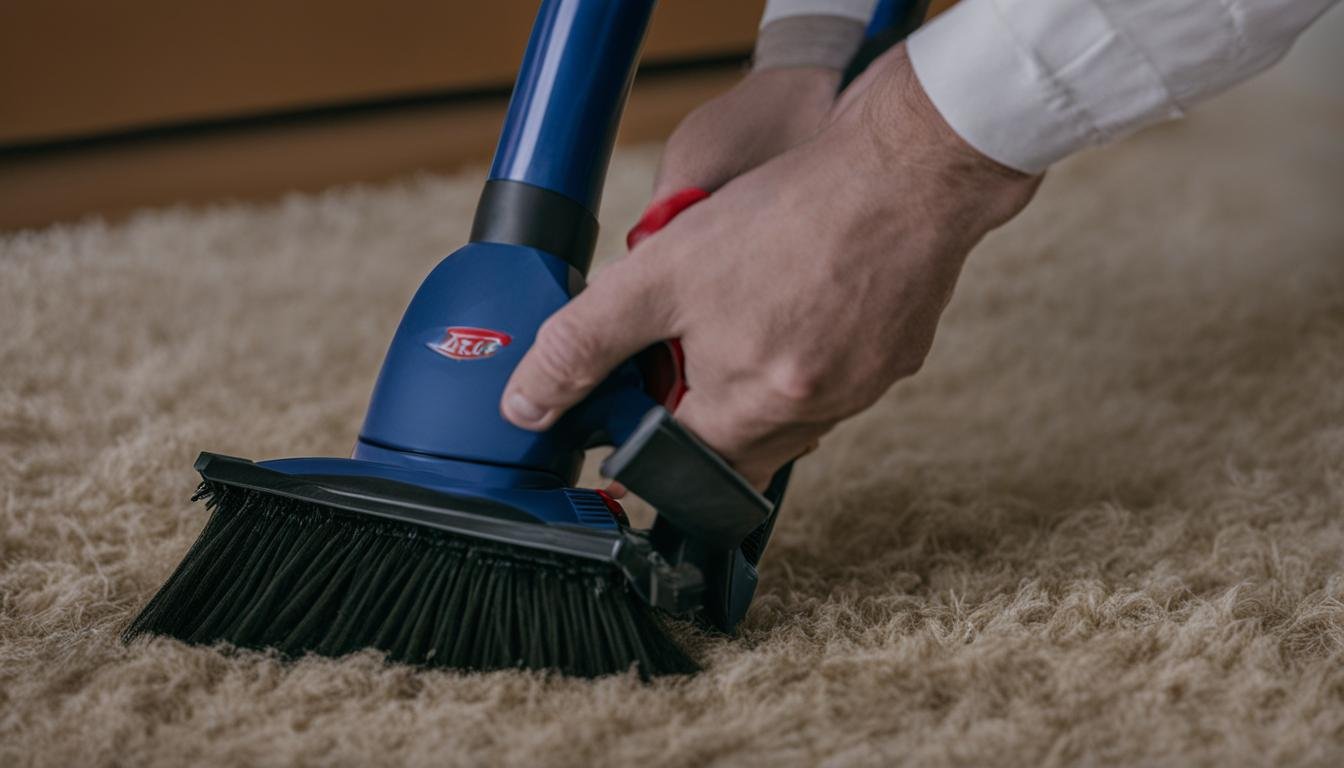As a proud owner of a vacuum cleaner, I understand the frustration of dealing with hair tangled in its brush roll. Not only does it impact the performance of your vacuum cleaner, but it can also be time-consuming to remove. That’s why I’m here to share some useful tips and tricks on how to effectively remove hair from your vacuum cleaner and ensure its optimal functioning.
Regular maintenance and cleaning are essential to keep your vacuum cleaner in top shape. By following these expert tips, you’ll be able to bid farewell to hair clogs and experience hassle-free cleaning sessions.
Key Takeaways:
- Regularly cleaning and maintaining your vacuum cleaner is crucial for its performance and longevity.
- Use methods such as the seam ripper, scissors, or safety cutter to remove hair from the brush roll.
- Prevent hair clogs by cleaning the brush roll after each use.
- Consider investing in vacuum cleaners specifically designed for pet hair if you have furry friends at home.
- Keep an eye on the filter and empty the dustbin regularly to optimize airflow and suction power.
Methods for Removing Hair from a Vacuum Cleaner
When it comes to maintaining the optimum performance of your vacuum cleaner, removing hair is essential. Hair clogs can hinder suction power and lead to inefficiency. Here are some tried-and-tested methods for effectively removing hair from your vacuum cleaner:
- Regular Brush Roll Maintenance: One of the best practices for cleaning a vacuum cleaner is to regularly check and clean the brush roll. Remove any hair or debris entangled in the brush bristles. This not only prevents hair clogs but also ensures efficient vacuuming.
- Using Seam Ripper: A seam ripper is a handy tool that can be used to gently cut and remove hair wrapped around the brush roll. Slowly insert the seam ripper under the tangled hair and carefully cut through it, loosening the grip on the brush bristles.
- Scissors or Safety Cutter Method: If the hair is tightly wound around the brush roll, carefully use a pair of scissors or a safety cutter to trim and remove the hair. Exercise caution to avoid damaging the bristles or causing any injury to yourself.
- Combing with a Fine-Toothed Comb: You can use a fine-toothed comb to comb through the brush bristles and remove hair. This method is effective for loosening the hair and untangling it from the brush roll.
- Preventing Hair Clogs: To minimize hair clogs in your vacuum cleaner, consider using a fabric softener sheet as a pre-filter, placing it inside the dustbin or canister. This can help reduce static electricity and repel hair, making it easier to empty the canister without any messy tangles.
By implementing these tips for removing hair from your vacuum cleaner and incorporating preventive measures, you can keep your vacuum running smoothly and effectively remove hair without any hassle.
Conclusion
Regularly maintaining and cleaning your vacuum cleaner is crucial for ensuring its optimal performance and extending its lifespan. One of the primary maintenance tasks is removing hair from the vacuum cleaner, as it can accumulate and affect its suction power. By following a few simple steps and using the right tools, you can effectively clean your vacuum cleaner and keep it functioning at its best.
When it comes to cleaning hair from the brush roll, there are several methods you can utilize. One popular method is using a seam ripper, carefully sliding it under the tangled hair and gently lifting it away. Another option is using scissors to cut through the hair and remove it. Additionally, a safety cutter can be used to safely and efficiently trim away any hair clogs that may be obstructing the brush roll.
Incorporating regular cleaning into your vacuum cleaner maintenance routine is equally important. This includes emptying the dustbin or bag after each use, cleaning the filters, and inspecting the brush roll for any hair or debris build-up. By doing so, you can prevent hair clogs and ensure that your vacuum cleaner continues to perform optimally.
By implementing these best practices for vacuum cleaner maintenance and regularly cleaning hair from your vacuum, you can keep your appliance operating at its peak efficiency, prolong its lifespan, and enjoy clean and effective suction power every time you use it.
FAQ
How can I remove hair from my vacuum cleaner?
There are a few methods you can use to remove hair from your vacuum cleaner:
1. Use a seam ripper to carefully cut and remove hair tangled around the brush roll.
2. Use scissors to cut through the hair and remove it from the brush roll.
3. Use a safety cutter to cut through the hair and remove it from the brush roll.
How often should I remove hair from my vacuum cleaner?
It is recommended to remove hair from your vacuum cleaner on a regular basis, ideally after each use or at least once a week. This will help prevent hair clogs and keep your vacuum cleaner running smoothly.
What other maintenance should I perform on my vacuum cleaner?
In addition to removing hair, it is important to regularly clean the filters and empty the dust canister or bag. This will help maintain optimal suction and prevent clogs. You should also check the brush roll for any other debris or obstructions, and clean or replace it as needed.
How can I prevent hair clogs in my vacuum cleaner?
To prevent hair clogs, there are a few tips you can follow:
1. Regularly remove hair from the brush roll using the methods mentioned earlier.
2. Avoid vacuuming large clumps of hair or excessive amounts of pet fur at once.
3. Consider using a vacuum cleaner with specialized attachments for picking up hair, such as a pet hair brush or a turbo brush.
4. For long hair, consider wearing a hairnet while vacuuming to reduce the amount of hair that gets into the vacuum cleaner.





Leave a Reply